Maranges
Tasting and terroir with Pablo Chevrot
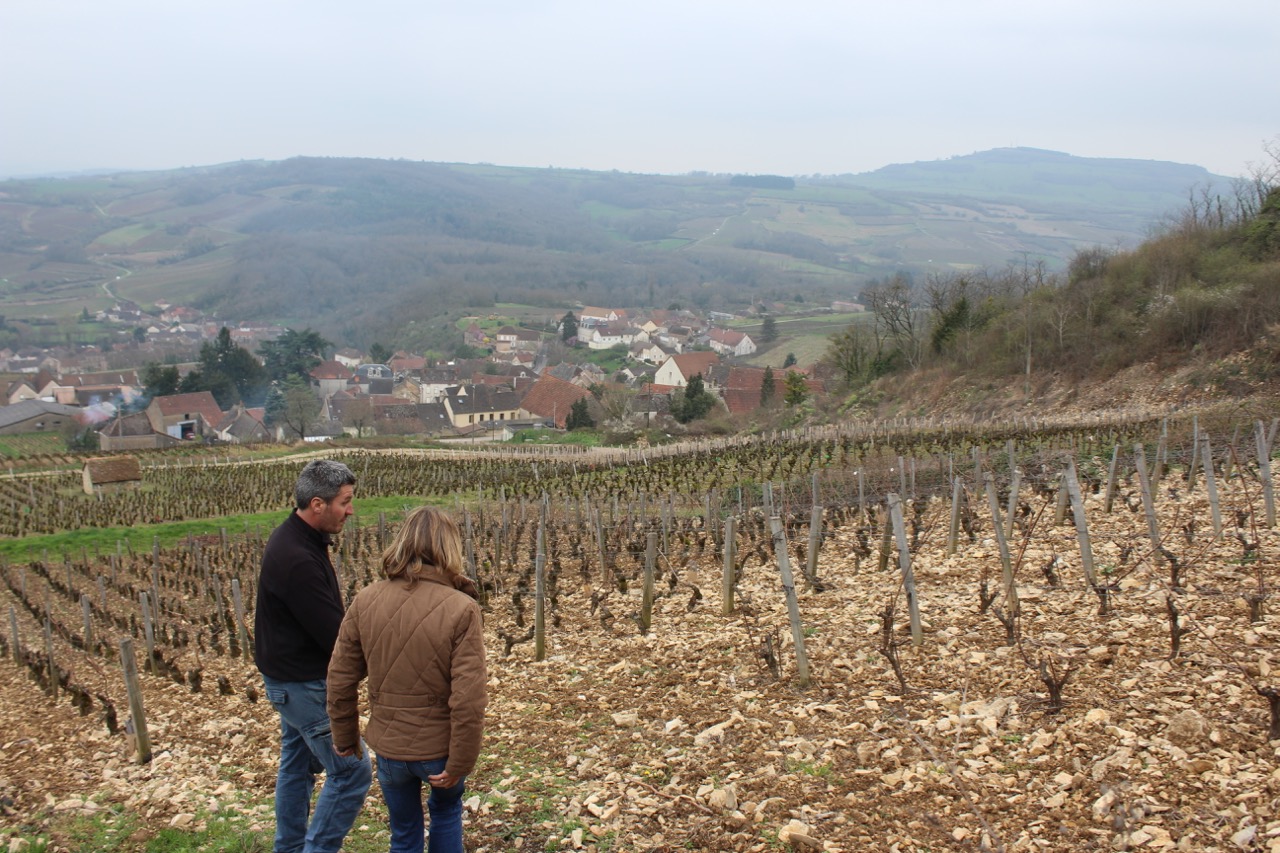
Maranges is the ‘wild south’ of the Côte d’Or, the seldom mentioned, southern extremity of the Côte de Beaune where the East facing Côte turns to face the South. It’s technically in the next département of Saone-et-Loire, but is part of the Côte d’Or and distinct from Côte Chalonnais hill range. If it has a reputation, it is for reds with robust tannins and good acidity and for the gorgeous scenery. It is a delight here.
The appellation was created in 1989 to encompass the three villages Cheilly, Sampigny and the unfortunately named Dezize. The vines cloak the south facing hillside. It’s rocky with a high percentage of limestone at the top mixing with clays on the terraces, moving down the hill to more gravels at the bottom. It’s frontier country where geological formations collide. There is even a large granite outcrop in the valley.
There are ten premier crus in a block across the slope in the upper section. I wanted to learn more about the premier cru La Fussière, which is a sizeable premier cru of 34 hectares shared between the villages of Cheilly and Dezize, and the tiny 1 hectare premier cru Croix Moines.
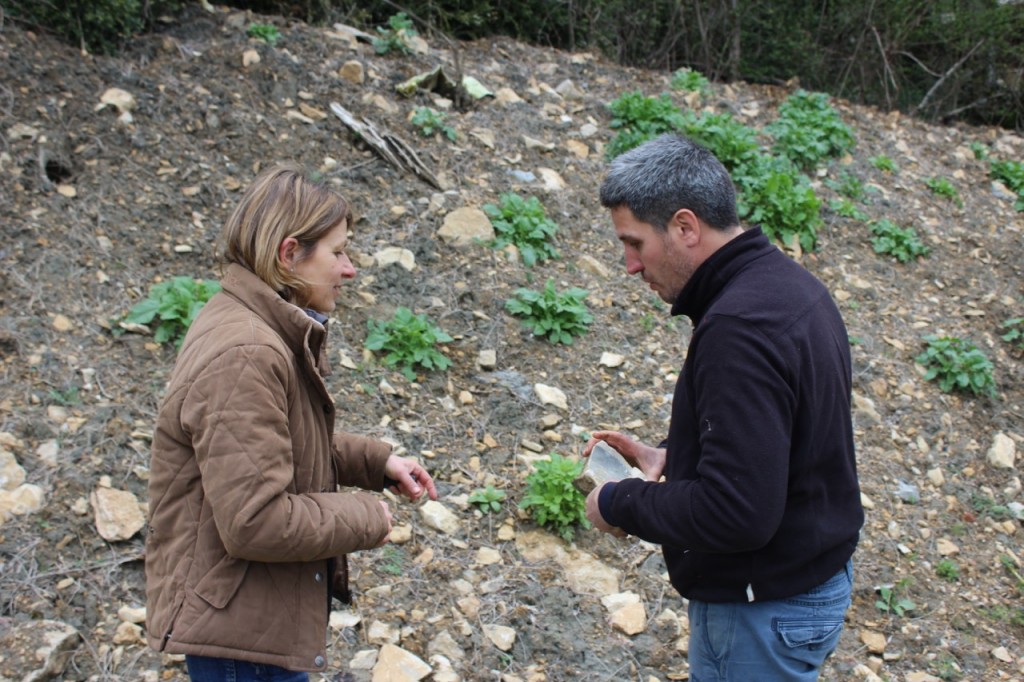
I arranged to see Pablo Chevrot. Domaine Chevrot make 16 wines across Maranges and the adjoining appellation of Santenay and Pablo is very well versed in the terroir of Maranges. He explains all in the film below. Be warned the film is long, but fascinating. There is too much good information to edit it down. Pablo spent a year studying geology and is passionate about communicating his knowledge of Maranges.
Domaine Chevrot has a parcel at the top of La Fussière, where the hill side breaks into rock and trees. This lofty part was recently reclaimed, ripping out the acacia, removing smaller rocks and cultivating around the larger ones. This tough looking terrain to grow vines was planted in 2010 with Chardonnay ATVB clones.
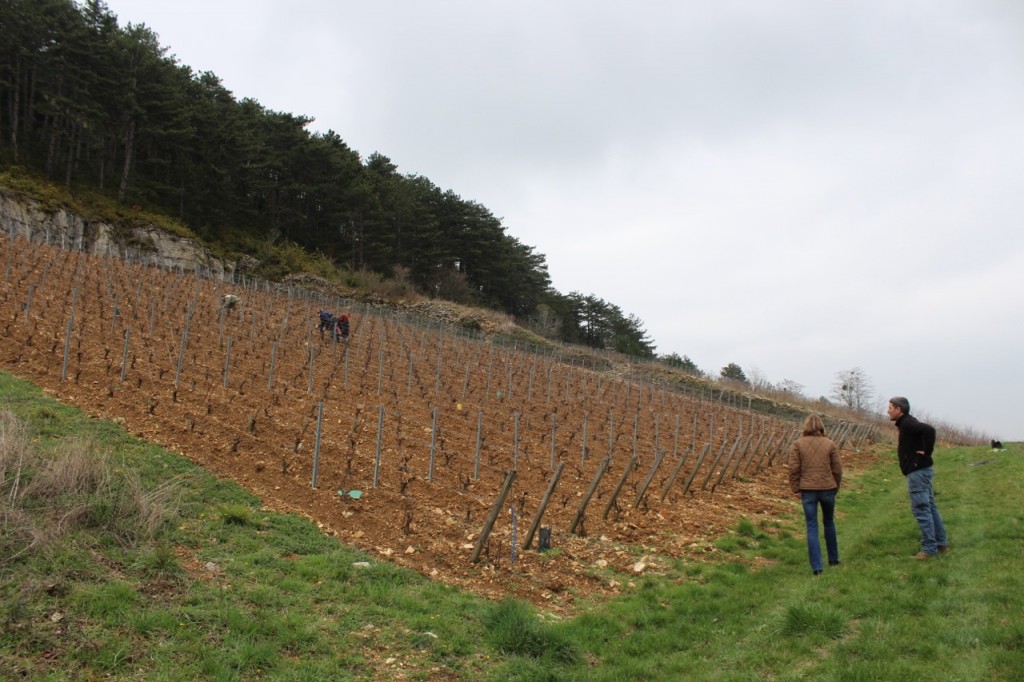
Just south of La Fussière is the tiny 1 hectare premier cru of La Croix Moines in the village of Dezize. As the name suggests this was the spot chosen by the monks who established an abbey in the village of Dezise just below.
I drove through the vineyards climbing steadily higher. Pablo had preferred to take my car – an unusual choice. Usually I hop into the vigneron’s little white van. My car felt decidedly bulky on the muddy narrow tracks and I soon regretted I’d bothered with the bi-annual clean.
“La Fussière is up there.” Pablo indicated a decidedly steep and stony incline off the track. I assumed we’d walk, but no, “just drive the car up… if you don’t want to, I’ll do it.” Well really. We strained and bumped 3 tonnes of metal to a halt at the top. The engine was thundering under the bonnet and there was no place to turn round. We had reached 360m.
In the young vineyard three women were tying down the canes in Pablo’s precipitous parcel of La Fussière… not an enviable task. With the panorama of the Maranges beneath us, Pablo explained the terroir in the film (below).
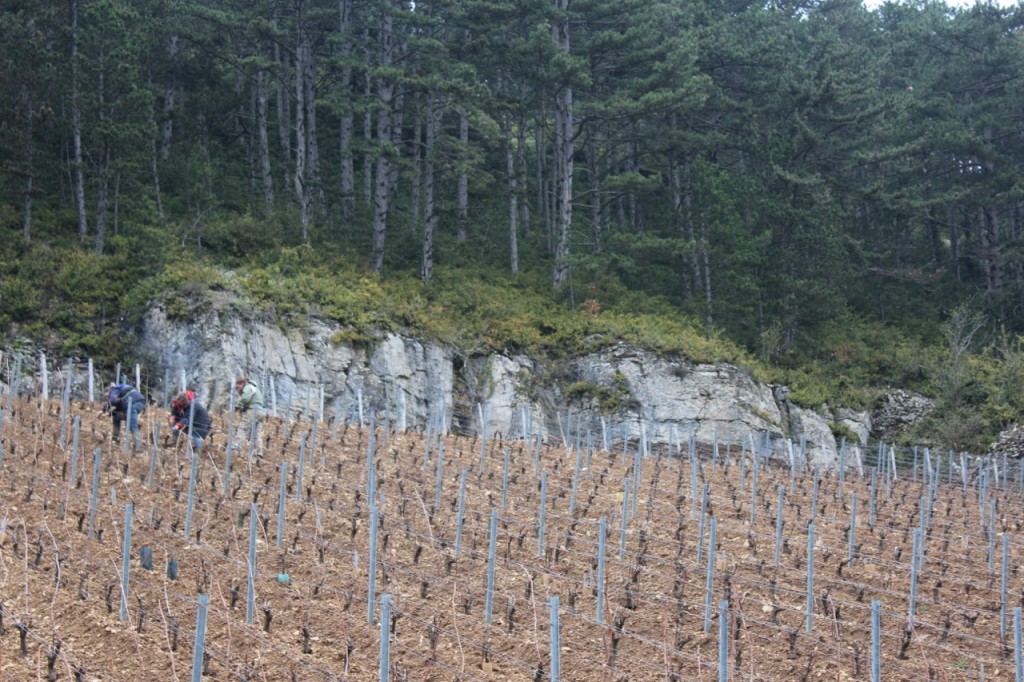
La Fussière may be planted in Chardonnay or Pinot Noir. Most is planted in red, but there is a trend to replant in white. Chevrot “It’s a natural place,” says Pablo, “as it turns to forest above.”
Domaine Chevrot farm organically, but lost their certified organic status in 2016. Pablo explains. “I had to treat in June with chemicals. Since 2004 we have not used any chemicals, but I could not lose an entire crop. Mildew had really got to the vines. We had 25 days of rain in May to mid June. We struggled. We sprayed by hand, but on the 10th June we had a week of rain and hot temperatures and it went from clean to mildew. Those who were organic harvested just 5 to 10 hl/hl and if you stayed organic, you used so much copper. If we had not had frost before it would have been different, but we had already lost too much to frost. It was a very hard decision.”
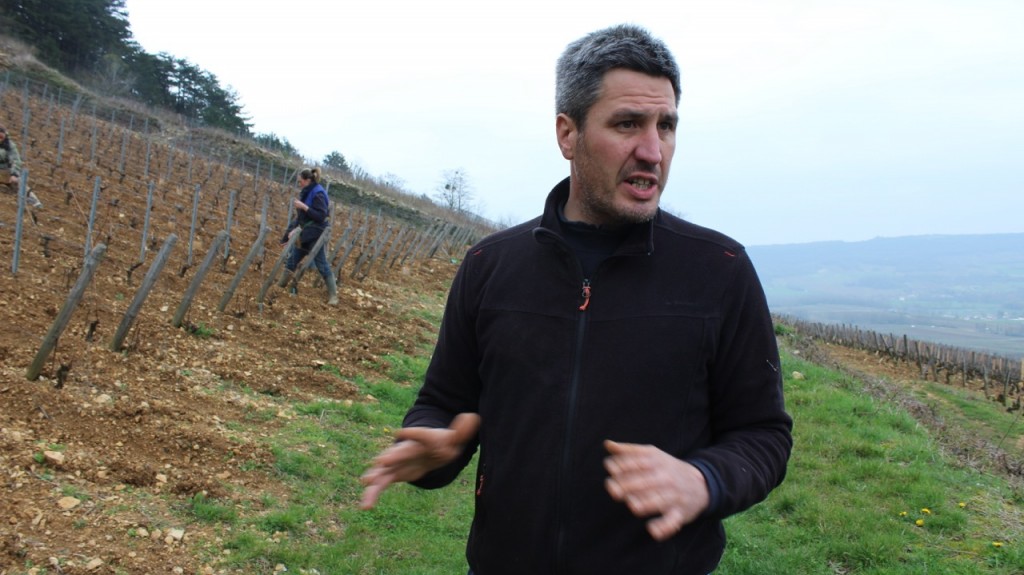
“We harvest the whites in the morning always with cold berries. We press cold and lower the temperature down to 10 degrees or less and put it into barrel. The yeast population will be very different with the temperature. You must press cold grapes or the quality will be compromised. So in the afternoon we stop processing the whites.”
“We press with a pH meter….end the press at 3.6. This part is not kept though. We crush, whole bunch but crushed. We settle very clean.” They use a vaslin press. “I like the extraction we get with it.” They used pneumatic on the 2013 as it was very fragile. “We put 2g of sulphur in the press. Straight to the pan… we’re very careful with oxidation as we use no sulphur for all the life of the wine. We feed the yeast some pure oxygen.”
They use one year old barrels. 2015 has a little new oak. If he can Pablo does not filter the whites. He fines whites (not the reds) with a little bentonite, “as we press with whole bunch.”
If the tasting below is any indication, La Fussière is a very good place for whites, better than for reds. This is a young vineyard and as the vines age, the wines will increase in depth and intensity.
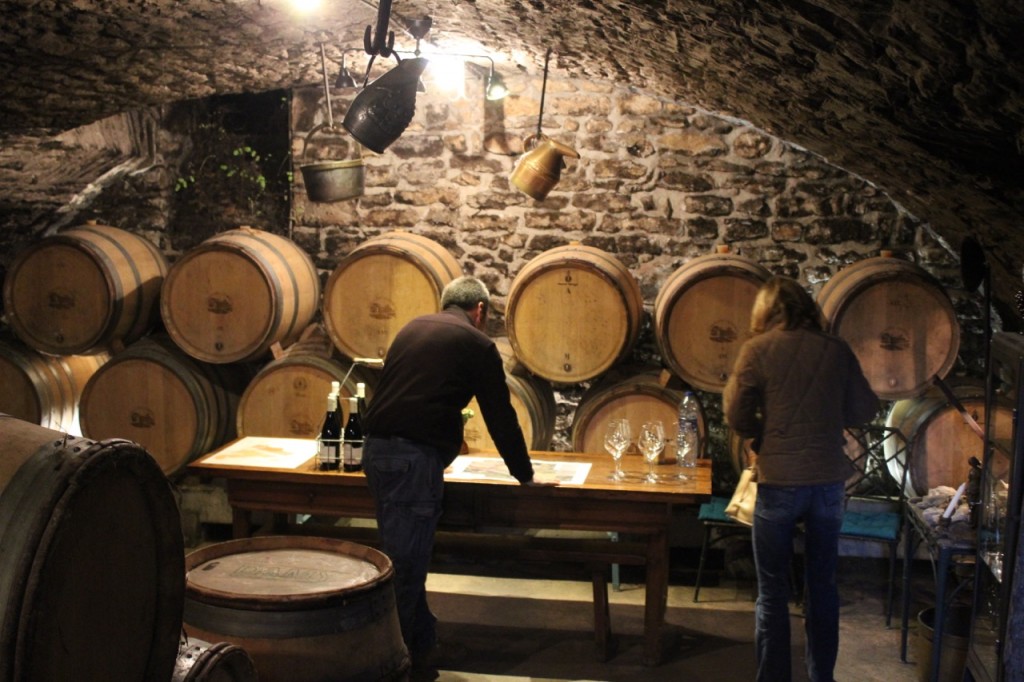
Tasting in the 1798 cellar under the house
Pablo’s wife Kaori, a Japanese wine taster, and son Angelo arrived with a birthday present during the tasting. Pablo had in New York and missed the day. It also happened to be Vincent’s birthday. Vincent joined the domaine in 2007, while Pablo began in 2002. Both are very well qualified and have a wealth of experience working at wineries around the world in addition to many in Burgundy. For a few minutes the cellar was full of the family, including the brothers’ father Fernand. He and his wife Catherine inherited in 1973 from his parents Paul and Henriette who created the domaine. Today it’s still very much a family affair with Vincent, Aureile and son Paul also living on at the domaine. They make 16 wines with a total production between 80-100,000 bottles.
Tasting Notes
Maranges, 1er cru, La Fussière Blanc
Maranges, 1er cru, La Fussière, Blanc 2013
“It was a very small crop. Lots of botrytis. Very small berries, maybe as the vines were very young. (The Pinot Noir was more resistant for some reason). It was hard to sort. Difficult, as we picked after the rain and the berries split.” They did not alter the composition. “I hate chaptalisation. These people need therapy.” It had one year maturation in barrel.
Fresh, orangey notes on the nose. Plenty of interest up front with hints of wild flower honey. It’s attractive, fruity, if a light in concentration mid palate. The finish is rather short, but has some attractive minerality. Not at all bad for young vines. To drink now. Score 15.5
Maranges, 1er cru, La Fussière Blanc 2014
Pure, stoney and reserved. It’s not fruity at first. This takes time to evolve in the glass and when it does, it is white peach. Firm structure. It is reserved and has sappy, stoney minerality and good acidity. Savoury, salty finish. There is a cut and minerality to this wine. Impressive for young vines. Score 16.5.
Maranges, 1er cru, La Fussière Blanc 2015
Not filtered. Rich pear notes combine with stoney character on the nose. It is richer, rounded and more powerful than 2014. Ripe density mid palate. I like the mineral grip here. There is a good presence in this young wine…at the end a sappy minerality. Score 16.5.
Maranges, 1er cru, La Fussière Rouges
This was share cropped for 30 years. (This is a traditional system called métayage whereby a vineyard is managed on behalf of the owner by a grower who receives half the crop. It can take years to break such agreements). 2008 was Domaine Chevrot’s first vintage after reclaiming it from the métayage agreement.
“It was not in organic farming before we took it back. We had just started to plough in 2009 and so we were did not have the maturity for the full bunch. 2009 was the last year I used sulphur. It was a vintage of conversion for these vines. It was not my viticulture. The yields were too high.”
Now they can use the whole bunch. “When the bunches are beautiful, we keep the bunches, so it is difficult to say what percentage of stems. We taste and decide.”
“Very few pieage and no remontage. We used very little press wine. If you want to do a wine with sulphur you cannot use press wine as this will decrease your pH. So just the first press. we used 30% new oak. 15 months ageing. Les Fussière rouges has almost no sulphur at bottling. Not filtered. Before harvest we rack it clean and put it in older barrels (5 to 12 fills) for 3 months and then stainless steel. So we do several rackings, as we do not filter.”
Pablo says, “you can smell the flint.”
Maranges, 1er cru, La Fussière 2015
An attractive, up-toned aroma with sweet hedgerow fruits. Slight smoky note. Firm attack. Good almost spiky energy. The tannins are ripe and enveloped in deep fruit with blackberry notes. Vibrant on the finish. Score 16.85
Maranges, 1er cru, La Fussière 2013
“A very long and cold season with harvest from the 24th September to the 10th October. 100mm of rain on the 11th, so we harvested just in time.”
Spicy aroma with a hint of blackcurrant. A straight palate. Quite lean tannins. Leafy, peppery notes. Blue fruit. Somewhat crunchy. Certainly fresh and zesty. The tannins are just ripe enough. It has piquancy. Good energy. Almost frizzles on the finish. A little tart, but enjoyably so. Score 16.
*Maranges, 1er cru, La Fussière 2012
This has a fresh iodine note on the aroma. Supple strike on the palate. Black pepper and exotic. Rich, firm and quite chunky. Thicker texture with some chocolate and prune notes. The tannins are plentiful and firm, but enveloped ripe fruit. I like the freshness and minerality at the end. Good vigour here. Score 16.75
Maranges, 1er cru, La Fussière 2009
This was de-stemmed given it was only the second vintage they were farming it themselves.
Ripe red fruit aroma. Moderate intensity. Sweet, soft and easy on the tannins. The palate is rounded. It is less intense and concentrated than the 2012 and less fine on the finish. It is seductive and pleasant, but does not have the energy of the wines Pablo has made since. The 2009 is a fabulous vintage, but I prefer the wine of the much more modest 2013 vintage, which shows the work in the vineyard.
Maranges, 1er Cru, La Croix Moines
La Croix Moines was planted 30 years ago with some newer planting in 2010. “It always gives good yields. 48 hl/ha. Normally we have to green harvest. The soil is very deep, flint and limestone and very little clay. It is a very difficult soil. We have never reached the mother rock. We have not hit marl even at 3m.” It’s a wide massale selection at the bottom of the parcel. The 2010 planting are the ATVB clones.
“With Croix Moines we have slower fermentations. The pHs are higher but the MLFs are longer. We use more like 70% whole bunch. The 2014 and 2013 vintages were matured just in older barrels, but the 2010 has new oak.”
Maranges, 1er cru, La Croix Moines 2014
Lightish colour. Lovely concentration on the nose with a hint of spice. Sweet and juicy strike. Rounded with good density in the mid palate. Very nice balance and harmony. It is elegant. It has a good length and is pure on the finish. Score 17.5
Maranges, 1er cru, La Croix Moines 2013
In this difficult vintage they harvested just 35 hl/ha, which is not usual in this vineyard.
Cool and lifted aroma. Silky and elegant on the palate. It is fresh and lighter bodied than the 2014, but really rather refined. Red cherries and cherry blossom. Quite delicate. Aromatic on the finish. Cherry kernel at the end. Score 17.5 It’s an excellent 2013. I like the 2014 and the 2013 equally, but they are very different. Score 17.5
Maranges, 1er Cru, La Croix Moines 2010
More oak showing, slightly more caramel notes. There is spice and rich intensity here. Lots of oak on the palate. It is juicy, fruity and dense. Good freshness and the tannins are fine textured. There is a juicy vibrance and intensity. It is very good indeed. Very long and bright on the finish. Score 17.75.

